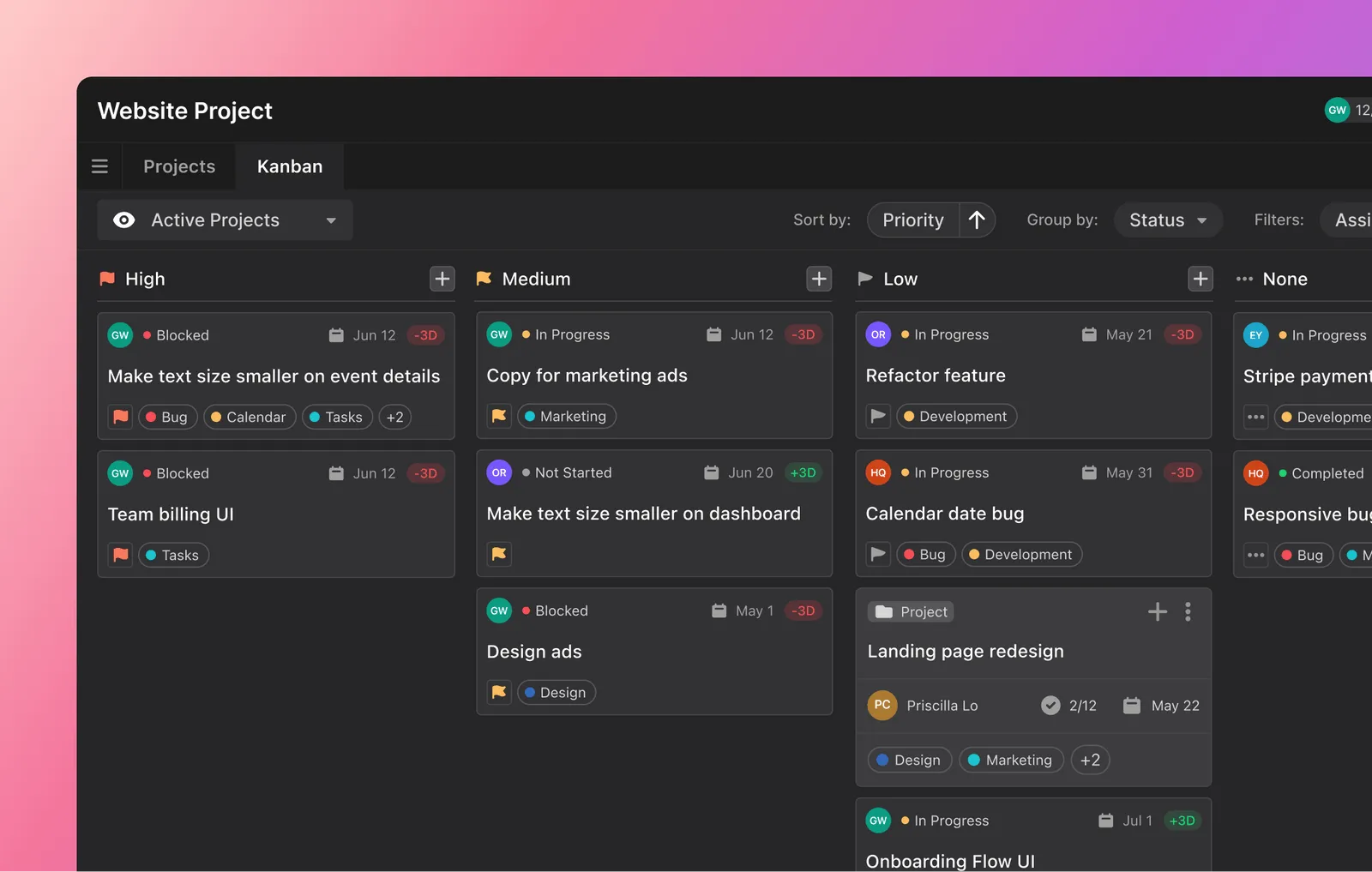Employees everywhere, attention: are you balancing too much work?
Do you have trouble prioritizing the multitude of tasks on your to-do list that drain the joy right out of your work?
If so, it’s likely that the last thing you want to hear about is how to be more productive.
Or — maybe not. In fact, being productive at work is not just about “getting things done.” It’s about feeling accomplished at the end of a workday because you know you ticked the right things off.
Productivity tools and techniques can reduce the pressure and take a big load off your shoulders by giving you a better grip on your day, whether you're an on-site or remote worker.
But keep in mind that underneath even the best productivity tools and techniques is something extremely powerful that only you have control over: your attitude toward productivity.
So let's explore six productivity areas and 30 practical things you can do to reduce work-related stress while making you more productive — starting with your mindset and ending with techniques for becoming the commander of your own to-do list!
Mindset and attitude
Almost one-third of employees dread going to work. They dislike the workload, the company culture, or other work aspects, which negatively impacts their happiness at work.
However, studies have found that as much as 40% of our happiness is influenced by our outlook on life — in other words, our mindset.
Our mind acts as a filter for how we experience life. We constantly have a choice to look at the positive or the negative side of what is thrown our way and absorb these influences into our lives.
Your best friend got a promotion, but you didn't? You can either let this fact pull you down into thoughts and feelings of anger and despair or let what your friend has accomplished lift you up.
Training yourself to have a positive outlook can significantly impact your overall well-being and success at work. A positive mindset can lead to increased motivation, creativity, and resilience, which results in higher job satisfaction and performance.
Here are seven tips for healthy habits that can help you manage your attitude at work:
1. Adopt a positive mindset
You can foster a positive mindset by training yourself to look at the bright side of things — not in a pollyannaish way, where you see everything through rose-colored glasses, but in a "looking for the silver lining" kind of way.
Spilled coffee all over your desk? You can think of it as half an hour lost to a pressing project (yikes!) or a great opportunity to finally clean your messy workspace (yay!).
2. Use positive self-talk
Positive self-talk can boost your confidence and motivation.
Remind yourself of your strengths and accomplishments, as in, "You really kept your cool when the boss yelled at you, Maria. Well done!"
Use self-talk to stay optimistic, even in difficult situations. Remember, every challenge is an opportunity for personal growth.
If you'd like some help with optimism, check out our post on 20 ways happy and productive people start their day right!
3. Focus on the end user
Always keep the customer or end user of your company's products in mind.
Your company makes pots and pans? Visualize a cook in a suburban home happily creating a great meal with the company pot.
Your company provides life insurance products? Think of an older couple happily snuggling on the couch with peace of mind because of your policy work.
Approaching your work this way can help you maintain a sense of purpose in what you do for a living.
4. Engage in team building
We all need meaningful relationships — including at work. Good relationships have a positive impact on emotional well-being, improved mental health, reduced stress, increased self-esteem, and a sense of belonging.
 |
One way to improve your relationships at work is to participate in team-building activities. These activities can strengthen connectivity, trust, and a positive work environment where everyone can thrive. If the company doesn't offer these kinds of activities, ask the boss to incorporate them!
5. Ask for feedback
Seek friendly feedback from your colleagues about how you're doing at work to help you improve your performance.
This may be scary at first, but it can help you identify areas for growth and development. This will ultimately make you a stronger team player and contributor.
6. Maintain a healthy work-life balance
Set realistic boundaries and include time each day for self-care activities, such as getting some sun, fresh air, or exercise.
By managing your personal needs, you'll be better equipped to perform at your best and contribute positively to your work environment.
7. Use humor
Lastly, don't forget the power of humor — not the sarcastic kind, but the genuinely funny type that evokes a chuckle and can diffuse tense situations.
A good laugh can lighten the mood, strengthen bonds, and help you and your colleagues navigate challenges more effectively together.
Self-improvement and growth
Work is often taxing on the mind and the body, but even stressful work can become more enjoyable if you approach it as a stepping stone to personal development and growth.
A business environment is a great place to focus on healthy habits, self-improvement, and growth. Did you know that 41% of employees leave their jobs due to a lack of career advancement and that 94% would stay longer if they had more learning opportunities?
But your employer isn't the only person who should provide you with avenues for growth. Here are six productivity tips you can use to set your own course toward personal development:
1. Embrace challenges as opportunities for growth
View obstacles as chances to learn, adapt, and improve. By adopting this mindset, you'll become more resilient and better equipped to tackle future challenges head-on.
2. Pursue personal development opportunities at the office
Attend available training sessions to expand your knowledge and skills. Look for opportunities to learn new skills. This will not only make you a more versatile and valuable employee but also enhance your overall well-being.
3. Get mentorship and guidance from experienced colleagues
Their wisdom and insights can help you navigate your career path more effectively, avoid potential pitfalls, and achieve your goals faster.
4. Offer to help colleagues with their tasks
Not only will this help strengthen your relationships with your teammates, but it'll also help broaden your skills and your understanding of different aspects of your work.
 |
5. Maintain a positive attitude toward criticism
Embrace criticism as a tool for self-improvement, and use it to refine your performance. This open-minded approach will enable you to become better at your job and develop some great people skills in the process.
6. Take time to reflect and evaluate your progress regularly
By assessing your achievements and identifying areas for growth, you'll be able to set more effective goals and continue to develop both professionally and in your personal life.
Communication and collaboration
Next, let's talk about communication and collaboration impact productivity in the workplace.
Effective communication with colleagues and management is critical for balancing your workload and meeting deadlines, especially in a small business where there's little room for error.
In fact, teams with strong workplace communication skills can experience up to a 25% increase in productivity!
So, by honing your communication and collaboration skills, you'll contribute to a more efficient work environment and enjoy greater success in achieving your goals.
Explore these six techniques for more efficient communication and collaboration:
1. Express your thoughts clearly and concisely
The time and money wasted in businesses and organizations due to incomplete or ambiguous explanations, confusing instructions, and obscure jargon and technical terminology is staggering.
It’s estimated that teams lose the equivalent of an entire workday (over 7 hours!) due to poor communication each day — and this totals around $12,500 lost per employee, per year.
And that’s why good communication is key — it begins with training yourself to express yourself clearly and concisely. Unfold your point logically by starting with a main point.
Rather than "We messed up this project," say, "Sorry, this project is delayed by a day" (main point). "My computer crashed this afternoon, so I had to redo the last third of the report" (relevant sub-points).
Clear communication fosters better understanding and more efficient, productive teamwork.
2. Practice active listening
When engaging with others, give them quality time in the form of your full, undivided attention to make the most of the communication. This is one of those healthy habits that make everything flow better.
 |
Minimize interruptions and ask clarifying questions. This will make you a better collaborator and reduce wasted time.
3. Use empathy and understanding toward your colleagues and customers
Putting yourself in other people's shoes can help you better appreciate their needs, concerns, and emotions.
This compassionate approach will enable you to better connect with others, leading to more positive experiences for everyone.
4. Collaborate with colleagues to share knowledge and ideas
Collaboration can involve more than just working on a project with others.
A powerful key to productive collaboration is sharing knowledge and ideas. In this way, you can leverage each other's strengths, learn from one another, and generate innovative solutions that drive success.
5. Proactively flag issues and problems as they arise
Take an active role in addressing concerns about a project or task early on — and, when necessary, bring those concerns to the attention of a higher-up.
This will minimize potential negative impacts, such as unnecessary delays, later down the line.
6. Don't hesitate to ask for help when you need it
Asking for assistance not only demonstrates humility and a willingness to learn but also helps you overcome obstacles more efficiently.
Workplace efficiency
Your physical environment plays a big role in how productive you can be.
Organizing and streamlining your workspace and work processes can reduce stress and increase productivity. So can finding ways to minimize distractions.
Believe it or not, the average office worker is productive for just 2 hours and 23 minutes daily.
And this isn't just a matter of letting your mind wander too much. Workers are interrupted every three minutes and five seconds, and it takes them a good 23 minutes and 15 seconds to refocus.
Here are six tips you can use to optimize your workspace for greater productivity and make the most of your valuable time.
1. Minimize distractions
Helpful ways to create a more focused work environment include turning off notifications, using noise-canceling headphones, or setting specific times for checking emails and social media.
 |
This will help you stay on track and maintain productivity throughout the day.
2. Streamline your tasks through automation
Identify repetitive tasks and find ways to automate them using technology.
Good examples include automation in email templates, data entry, electronic document signing, synching documents, making file back-ups, and invoicing/billing.
Automation technology can save time and energy so that you can focus on more important and strategic work.
3. Identify and eliminate time-wasting activities
Regularly assess how you spend your day, and identify time wasters. Cut out unproductive habits (such as checking your emails every 10 minutes) and replace them with more meaningful tasks that speed up your productivity.
4. Stop multitasking
Multitasking isn't as effective as people think. In fact, research has found that only about 2.5% of people can multitask in a productive way.
That's because our brains are designed to focus on one thing at a time. When we constantly bounce back and forth between different tasks, we become less efficient and may even make more mistakes.
So be a mono-tasker instead. Focus on completing one task at a time. Giving your full attention to each task will help you increase your efficiency, produce higher-quality work, and reduce the likelihood of errors.
5. Follow up on tasks and projects to stay on top of timely completion
By regularly checking on progress and addressing any delays, you'll keep things moving forward and demonstrate your commitment to achieving goals.
Consider using project management software to make this task easier and help you stay on track.
6. Look for opportunities to work part-time from home
Remote workers often experience fewer distractions and interruptions, allowing them to focus better on their tasks and responsibilities. This contributes to not just increased productivity but also a better work-life balance.
So, if your job type allows for it, working part-time from home is a great way to streamline your work output.
Goal setting and planning
Lastly, let's talk about another big component of being productive: goal setting and planning.
Goal setting leads to more focused performance and higher achievement rates — especially when you write down your goals.
One study found that you're 42% more likely to achieve your goals when they're written down. That's too good to pass up, isn't it?
So, try the following five methods to boost your productivity in the planning realm:
1. Set clear, achievable goals, and write them down
Documenting your objectives will give you a tangible reminder of what you're working toward. This helps you stay focused and motivated to succeed.
2. Prioritize tasks based on their urgency and importance
It might be tempting to focus on the easy routine tasks when you start your day, but this can lead to unnecessary procrastination.
Avoid this pitfall by tackling urgent and important tasks first to get them out of the way. Once those are done, you can relax a bit more and deal with your less urgent tasks. This approach will help you use your time more effectively and ensure you're not overlooking high-priority tasks.
3. Break down projects into small steps
Divide large tasks into smaller, more manageable chunks, and set deadlines for each step. This will make the overall project seem less daunting and help you maintain momentum as you work toward completing the project at hand.
4. Keep track of — and celebrate — your accomplishments
To keep you engaged, find ways to celebrate your successes, both big and small. For instance, promise yourself a half-day off for a hike or a movie after you complete a big project.
These simple recognition rituals can boost your motivation, improve your self-confidence, and help you maintain a positive outlook on your work.
5. Use productivity tools
There are many productivity tools that can help you stay organized and on track. These include online calendars, project management tools, and time management apps.
Explore time management techniques, such as timeboxing or time blocking, to increase your focus and efficiency throughout the day.
 |
And did you know that the old to-do list approach to productivity can actually make you less productive? Read on to find out why — and what to do about it!
Try a new to-do list approach: Motion's AI platform
Conventional to-do lists can be overwhelming because there's typically too much in them — and they're often ineffective because they make it difficult to gauge what's important and what isn't.
You may be faithfully chipping away at your never-ending to-do list every day but never really know if you're accomplishing your overarching goals.
That's why Motion has introduced a game-changing alternative app designed to revolutionize the way you work. This innovative tool helps you stay organized, minimize distractions, and focus on the tasks that matter most.
Adopting Motion for your work can help you plan your day by building intelligent, flexible to-do lists. In fact, it has been shown to increase productivity by as much as 137%!
And supervisors: Motion lets you stop worrying about coordinating your team by always letting you know whether you're on track and reducing the need for manual planning.
Now go forth and be productive!
Even in the busiest business environments, you can incorporate productive tools to help make your work life less hectic.
Try the productivity hacks listed in this article, from adopting a positive mindset to incorporating time management techniques and more. Experiment with new ways of tackling your daily routine, and prove to yourself that the satisfaction of greater productivity is within your grasp.
Even if you start with just a few productive strategies, you'll soon develop a personal productivity habit that clears the way for gradually incorporating more efficiency-boosting practices into your life.
As part of these strategies, try out Motion's AI-powered time and project management platform. It's a superior alternative to traditional to-do list apps — and can save you two hours each day so you can focus more on your favorite productive tasks.
Ready to unlock your most productive potential with Motion? Get a 7-day free trial here to give it a try!







